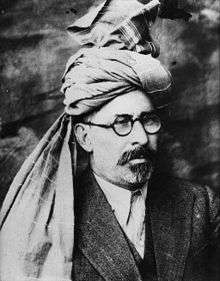Sher Khan Nashir

Sher Khan Nasher (Sher Mohammad Nashir) was the hereditary Grand Khan (Loe Khan) of the Kharoti (Ghilzai) tribe and governor of the Kunduz region in the 1930s.[1]
Life

Born as the son of the Khan of the Nasher clan of Ghilzai Kharoti Pashtuns, he left Ghazni in the early 20th century as the Nasher family was exiled by the ruling Durrani King Amir Abdur Rahman Khan in order to weaken his nemesis.[2] Sher Khan launched an industrialization campaign with major urban development and construction programmes of what then became Kunduz.[3][4] He is also known as the founder of the Spinzar Cotton Company in Afghanistan, and implemented Qizel Qala harbour that was later named Shir Khan Bandar.[5] In addition, several schools in Afghanistan are named after him.[6][7][8][9][10][11] There are rumours he was killed by the leading Barakzai king for fear of being de-throned by a Ghilzai Khan.[12]
Legacy
His nephew Ghulam Sarwar Nasher continued the economic development and transformed Kunduz into a thriving city with new residential housing, schools, and hospitals for the Spinzar factory workers.[13] Kunduz became one of the wealthiest Afghan provinces, Spinzar Cotton Company became the largest and most successful private enterprise in the country with about 20,000 employees.[14] The Afghan singer Farhad Darya Nasher is his nephew .Several schools were named after Sher Khan Nasher,[15][6][16] with many high-profile graduates, such as Hekmatyar,[17][18] Farhad Darya Nasher,[6] Dr. Saddrudin Sahar [19] and Suleman Kakar[20]
See also
References
- ↑ Ludwig W. Adams (1979). First supplement to the Who's who of Afghanistan: Democratic Republic of Afghanistan. Akademische Druck- u. Verlagsanstalt. p. 41. ISBN 978-3201011136.
- ↑ Peter Tomsen (2011). The Wars of Afghanistan: Messianic Terrorism, Tribal Conflicts, and the Failures of Great Powers. PublicAffairs. p. 42.
- ↑ Wörmer, Nils (2012). "The Networks of Kunduz: A History of Conflict and Their Actors, from 1992 to 2001" (PDF). Stiftung Wissenschaft und Politik. Afghanistan Analysts Network. p. 8
- ↑ Grötzbach, Erwin: Afghanistan, eine geographische Landeskunde, Darmstadt 1990, p. 263
- ↑ Tanwir, Halim. Afghanistan: History, Diplomacy and Journalism Volume 1. p. 253.
- 1 2 3 Books LLC (Editor). "Afghan Composers: Farhad Darya". BARNES&NOBLE. Retrieved 2015-03-22.
- ↑ Wahidullah (2011-03-03). "School building constructed in Kunduz". PAJHWORK AFGHAN NEWS. Retrieved 2015-03-22.
- ↑ "Hekmatyar, Gulbuddin (1948-)". UC Press E-Books Collection, 1982-2004. Retrieved 2015-03-22.
- ↑ Kakar, H.M.: The Soviet Invasion and the Afghan Response, 1979-1982, p. 307
- ↑ "Biography of Doctor Sadruddin Sahar Deputy for Administrative and Financial Affairs Ministry of Commerce and Industries". Islamic Republic of Afghanistan. Retrieved 2015-03-22.
- ↑ "Afghan Biographies -Kakar, Sulaiman". Afghanistan Online. Retrieved 2015-03-22.
- ↑ del Castill, Graciana. Guilty Party: The International Community in Afghanistan. p. 58.
- ↑ Emadi, Hafizullah. Dynamics of Political Development in Afghanistan. The British, Russian, and American Invasions. p. 60.
- ↑ Louis Dupree (2002). Afghanistan. Oxford University Press. p. 474. ISBN 978-0195776348.
- ↑ Roy, O.; Sfeir, A.; King, J. (eds.). The Columbia World Dictionary of Islamism. p. 130.
- ↑ http://www.pajhwok.com/en/2011/03/03/school-building-constructed-kunduz
- ↑ http://publishing.cdlib.org/ucpressebooks/view?docId=ft7b69p12h;chunk.id=s1.17.8;doc.view=print
- ↑ Kakar, H.M.: The Soviet Invasion and the Afghan Response, 1979-1982, p. 307
- ↑ http://moci.gov.af/en/page/7514/7523/7679
- ↑ http://www.afghan-bios.info/index.php?option=com_afghanbios&id=2436&task=view&total=2916&start=1234&Itemid=2
External links
| Wikimedia Commons has media related to Sher Khan Nasher. |